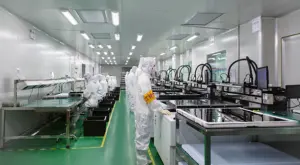In the first half of 2023, the display industry experienced what may be considered to be mixed fortunes. A slew of half-yearly guidances by companies such as Samsung, BOE, Tianma, and Visionox, have painted a grim picture of weak demand, and profit hits. But, we have also seen LCD TV panel prices rise and improve profitability although the small- and medium-sized display markets continue to face challenges due to declining prices and weak demand.
Yet, as the second half of the year gets going, there is some enthusiasm for the prices of LCD TV panels to continue to rise, and shipments of small- and medium-sized panels for smartphones and other devices to increase, have a sort of rebound from the recent doldrums. As panel volume and prices simultaneously increase, the profitability of panel manufacturers is expected to improve significantly.
Chinese panel manufacturers have gained significant market share in the LCD TV panel market, surpassing Korean manufacturers for the first time. Buoyed by very severe inventory management, panel manufacturers have been able to drive up prices and improve profitability, if not able to drive up the demand for their products because the industry is not running at anywhere near full capacity.
One bright spot for the industry is flexible OLED production lines improved yield rates and increased capacity, meeting the growing demand for flexible displays in the smartphone sector. There have been substantial increases in shipments of flexible AMOLED panels for smartphones. The general consensus among display manufacturers is that foldable smartphones fit into the premium category of devices, which is where most vendors want to concentrate offerings the feeling being that this segment is immune to the macroeconomic woes that the phone industry is facing.
Automotive is still a bright spot and holds great potential, but it is also a hard market to break into for traditional vendors without the infrastructure to support OEMs and Tier 1 partners in this new market. One thing that is certain about the market is that it affords manufacturers a tremendous amount of creative leeway, which allows for differentiation through innovation, and not just through process and inventory control. Bob Raikes’ review of the automotive displays at Display Week 2023 really highlighted what a rich seam of opportunity automotive is turning out to be.
LG has a very strong presence in the automotive market and is predicting huge order backlogs for its in-car displays by the end of this year, but here’s where the mixed bag comes in because, LG is also reorganizing its business, and is becoming a platform company in its TV business. Samsung is also facing its own internal and external pressures to become agile to face down threats to its businesses. For vertically integrated companies like Korea’s two giants, the challenges of economic uncertainties, the geopolitical issues of realigning supply chains, and general uncertainty about growth in semiconductors, displays, and consumer electronics, are all necessitating big organizational changes. These changes mean that the traditional display businesses of these companies have to change, too, not only because of the internal needs of the company but also as Chinese vendors have aggressively responded to the threats of sanctions and economic isolation wrought by a tenuous relationship with the US government.
And, in the midst of all this is the mixed bag that is Apple. Apple holds a lot of sway over the future plans of the display industry because it is seen as a powerful enabler of new technologies. The Apple Vision Pro is supposed to spur growth in the AR/VR market. Apple’s adoption of OLED and MicroLED display technologies is supposed to broaden their appeal and adoption in all electronics segments. Yet, it’s a mixed bag of news there, too. The Vision Pro is not going to do anyone any favors for a long time. It has been rushed to market, and it appears that all the expectations for its first year, however modest they initially were, have been weighed down by the reality that the product is expensive, and has expensive display components that cannot be produced at any of the volumes that Apple was expected to deliver.
It is also a constant churn of expectations and rumor around any use of new display technologies in upcoming Apple Watches, laptops, or phones. Apple is big and powerful, but it is not immune to the fact that the latest display technologies may not be able to meet its stringent quality controls at scale, and that the company is also not immune to pricing pressures in a downturn. It’s a mixed bag.
What we will continue to see, no doubt, is more emphasis on the higher-end range of products in TVs, computers, and smartphones by all vendors. TCL’s latest launch in China of its 95-inch QD-MiniLED TV is a prime example of where the biggest and brightest launches have to position themselves to create market impetus. Samsung and LG have done similar moves. Even the Indian market has seen its fair share of product launches aimed at the premium audience, despite the country having become a darling of companies like Apple and Acer, as they pursue growth in the region.
Without meaning to disappoint you, having got this far, but the summary of all that has happened is that nothing is certain for the second half of 2023. Companies have to paint a picture of hope and opportunity for their investors, customers, and shareholders, but that doesn’t mean there is a rebound or uptick just around the corner. It’s more like mixed bags, at best.

